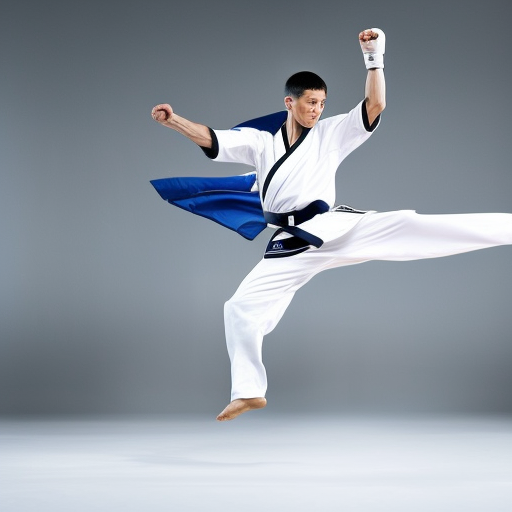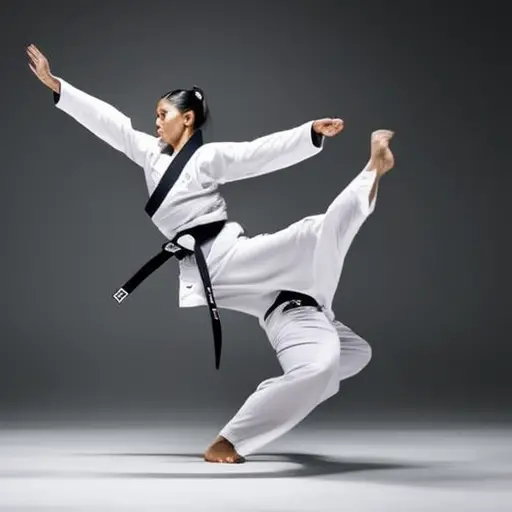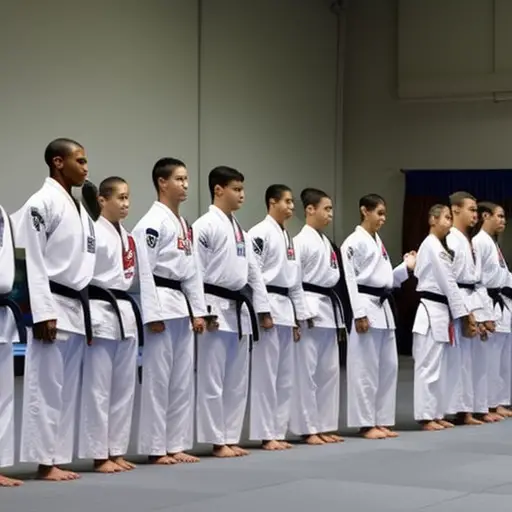The Origin and History of Taekwondo

Step into the world of taekwondo, a martial art that embodies discipline, precision, and strength.
Imagine the ancient roots of this art form, stretching back to the dynasties of Korea. Visualize the fusion of Chinese and Japanese influences that shaped its evolution.
Delve into the modernization of taekwondo in the 20th century, leading to its global spread and popularity.
Join us on a journey through the origin and history of taekwondo, unravelling its impact on modern society.
The Ancient Origins of Taekwondo
Tracing back through centuries of martial arts traditions, the ancient origins of Taekwondo can be found in the Korean peninsula. Taekwondo, which means ‘the way of the fist and foot,’ has a rich history that is deeply rooted in the culture and traditions of Korea.
The practice of martial arts in Korea can be traced back as far as the 1st century BCE, with historical ties to the Three Kingdoms period. During this time, martial arts were not only practiced for self-defense but also for military training.
The ancient origins of Taekwondo can be attributed to the influence of various martial arts styles that were present in Korea. One such style, known as Taekkyon, is believed to have laid the foundation for Taekwondo’s kicking techniques. Taekkyon was a traditional martial art that emphasized fluid and graceful movements, as well as high and spinning kicks.
In addition to Taekkyon, other martial arts styles from neighboring countries, such as China and Japan, also had an impact on the development of Taekwondo. The historical ties with China, for example, brought in elements of Chinese martial arts, including the use of hand techniques and forms.
The Influence of Chinese Martial Arts on Taekwondo
The influence of Chinese martial arts on Taekwondo is undeniable and has played a significant role in shaping the art form. Techniques such as kicks, strikes, and stances were borrowed from Chinese martial arts and adapted to suit the Korean style.
Furthermore, the historical ties between Korea and China have facilitated the exchange of knowledge and training, leading to a cross-pollination of martial arts techniques and philosophies.
Chinese Martial Arts Influence
During the early development of Taekwondo, Chinese martial arts had a significant influence on its techniques and principles. This influence can be attributed to the cultural exchange between Korea and China, which allowed for the exchange of knowledge and practices in martial arts.
Some of the key ways in which Chinese martial arts influenced Taekwondo include:
-
Forms and movements: Many of the forms and movements in Taekwondo have roots in Chinese martial arts, such as the circular movements found in Tai Chi and the explosive kicks seen in Shaolin Kung Fu.
-
Breathing techniques: Taekwondo incorporates breathing techniques from Chinese martial arts, which help practitioners generate power and focus their energy during training and combat.
-
Philosophical principles: Chinese martial arts philosophy, including concepts like balance, harmony, and respect, also influenced the development of Taekwondo, shaping its values and guiding principles.
Techniques Borrowed From China
One of the key ways in which Chinese martial arts influenced Taekwondo was through the incorporation of various techniques that were borrowed and adapted to fit the Korean martial art.
Taekwondo originated from Korea, but it has a rich history of interaction and exchange with Chinese martial arts. Throughout history, there have been numerous cultural and historical exchanges between Korea and China, which facilitated the transfer of knowledge and techniques.
Chinese martial arts techniques such as kicks, strikes, and stances were adopted and modified to suit the unique characteristics of Taekwondo. These techniques enhanced the effectiveness and versatility of Taekwondo, allowing practitioners to develop a comprehensive and well-rounded skill set.
The influence of Chinese martial arts on Taekwondo highlights the importance of cross-cultural exchange and the continuous evolution of martial arts throughout history.
Historical Ties With China
Throughout its development, Taekwondo has been heavily influenced by Chinese martial arts, with a strong historical connection between the two countries. The historical ties between Korea and China have fostered a cultural exchange that has greatly impacted the development of Taekwondo.
-
Styles: Chinese martial arts such as Shaolin Kung Fu and Tai Chi have played a significant role in shaping the techniques and movements of Taekwondo.
-
Philosophy: The philosophical aspects of Chinese martial arts, such as the emphasis on discipline, respect, and self-control, have also influenced the mindset and values of Taekwondo practitioners.
-
Weapons: The use of weapons in Chinese martial arts, such as the staff and sword, have been incorporated into Taekwondo forms, adding diversity and complexity to the martial art.
This historical connection and cultural exchange between China and Korea have not only enriched the techniques and philosophy of Taekwondo but have also strengthened the bond between the two nations.
The Role of Japanese Martial Arts in the History of Taekwondo
Historically, Japanese martial arts have frequently played a significant role in shaping the development of Taekwondo. The influence of Japanese martial arts on Taekwondo techniques is undeniable. During the Japanese occupation of Korea in the early 20th century, many Koreans were exposed to Japanese martial arts such as Karate and Judo. This exposure led to the incorporation of certain Japanese techniques into the Korean martial art of Taekwondo.
To better understand the role of Japanese martial arts in the history of Taekwondo, let us consider the following table:
| Japanese Martial Art | Taekwondo Technique |
|---|---|
| Karate | Punches and Kicks |
| Judo | Throws and Grappling |
| Aikido | Joint Locks and Throws |
| Kendo | Sword Techniques |
As seen in the table, the influence of Japanese martial arts can be observed in various aspects of Taekwondo. Karate has greatly influenced Taekwondo’s striking techniques, while Judo has contributed to its throws and grappling techniques. The principles of Aikido, such as joint locks and throws, have also made their way into Taekwondo. Additionally, some sword techniques from the Japanese martial art of Kendo have been adapted into Taekwondo forms.
The Modernization of Taekwondo in the 20th Century
The modernization of Taekwondo in the 20th century was marked by influential efforts that aimed to shape and refine the martial art. Various individuals and organizations played a crucial role in promoting and spreading Taekwondo on a global scale, leading to its recognition as an official sport in many countries.
Alongside its global impact, Taekwondo also witnessed an evolution in training techniques, with practitioners incorporating new methods and technologies to enhance their skills and performance.
Influential Modernization Efforts
Significant advancements in training techniques and competition rules were pivotal in the modernization of Taekwondo during the 20th century. These efforts aimed to make Taekwondo more inclusive and accessible to a wider audience while also preserving its cultural heritage.
Inclusion initiatives: The introduction of gender-inclusive training programs and the establishment of organizations dedicated to promoting diversity within the sport allowed for greater participation from individuals of all backgrounds and abilities.
Cultural preservation: Emphasizing the importance of traditional techniques, forms, and values ensured that Taekwondo remained deeply rooted in its Korean origins, even as it evolved to meet the demands of the modern era.
Technological advancements: The integration of modern training equipment and tools, such as electronic scoring systems and video analysis, revolutionized the way Taekwondo was practiced and evaluated.
These modernization efforts propelled Taekwondo onto the global stage, leading to its widespread recognition and impact on the international sports community.
Global Impact and Recognition
Notably, as Taekwondo evolved and modernized throughout the 20th century, its global impact and recognition grew exponentially. Taekwondo’s journey from a traditional Korean martial art to an internationally recognized sport has been marked by its cultural significance and widespread popularity.
The establishment of international governing bodies, such as the World Taekwondo Federation (WTF) in 1973, played a crucial role in promoting the sport on a global scale. The inclusion of Taekwondo as an official Olympic sport in 2000 further solidified its status and brought it to the attention of millions of people worldwide.
Today, Taekwondo enjoys a strong presence in over 200 countries and is practiced by millions of individuals of all ages and backgrounds. Its global recognition as a disciplined sport that promotes physical fitness, mental strength, and self-defense skills continues to grow, making it one of the most popular martial arts in the world.
Evolution of Training Techniques
Throughout the 20th century, the progressive development of training techniques played a pivotal role in the modernization of Taekwondo. This evolution was driven by the need to improve performance and enhance the effectiveness of practitioners. Two key aspects contributed to this transformation: the evolution of training equipment and the incorporation of sports science.
The evolution of training equipment: Traditional methods of training in Taekwondo relied on limited resources and simple tools. However, as the art form gained popularity, new equipment was introduced to aid in training. This included the development of target pads, kicking bags, and protective gear, which allowed practitioners to enhance their techniques and train more effectively.
Incorporation of sports science: As Taekwondo became recognized as a competitive sport, the incorporation of sports science became crucial. This involved the application of biomechanics, physiology, and psychology to optimize training methods. Scientific approaches to training, such as periodization, plyometrics, and strength conditioning, were adopted to improve performance and prevent injuries among athletes.
The evolution of training techniques and the incorporation of sports science have greatly contributed to the modernization and effectiveness of Taekwondo. These advancements laid the foundation for the formation of the World Taekwondo Federation, which will be discussed in the subsequent section.
The Formation of the World Taekwondo Federation
In the late 1960s, the World Taekwondo Federation (WTF) was established to serve as the international governing body for the sport of taekwondo. The formation process of the WTF involved the collaboration of various taekwondo organizations from different countries. In 1966, the Korea Taekwondo Association (KTA) held the first international taekwondo championships, which brought together practitioners from around the world. The success and growing popularity of these championships led to the need for a unified governing body to oversee the sport’s development on a global scale.
With the support of the KTA, the WTF was officially formed in 1973, and it quickly gained international recognition. The federation’s primary objective was to promote and regulate taekwondo worldwide, ensuring standardized rules, regulations, and training methods. It aimed to facilitate international competitions and establish a ranking system that would allow practitioners to compete at the highest level.
The establishment of the WTF marked a significant milestone in the history of taekwondo, as it unified the various taekwondo organizations and provided a platform for the sport’s development on a global scale. The federation’s efforts have played a crucial role in elevating taekwondo to an Olympic sport, with its inclusion in the 2000 Sydney Olympic Games.
As the WTF took on the responsibility of governing taekwondo internationally, it also sparked the evolution of taekwondo techniques and training methods. This subsequent section will delve into the changes and advancements that have shaped the sport over the years, ultimately leading to its current form.
The Evolution of Taekwondo Techniques and Training Methods
Advancing alongside the growth of the World Taekwondo Federation, the evolution of taekwondo techniques and training methods has been a dynamic and continuous process. Over the years, practitioners and instructors have constantly sought to improve and refine the techniques used in this martial art.
-
Enhanced kicking techniques: Taekwondo is renowned for its powerful and high-flying kicks. As the art has evolved, practitioners have developed new and more effective kicking techniques, such as spinning kicks and jumping kicks, adding complexity and versatility to their repertoire.
-
Incorporation of other martial arts: Taekwondo has also borrowed techniques and concepts from other martial arts, such as boxing and Muay Thai. This cross-pollination has enriched the art, providing practitioners with a wider range of striking techniques and defensive strategies.
-
Advanced training methods: With the advancement of sports science, training methods in taekwondo have become more sophisticated and specialized. Conditioning programs, strength and flexibility training, and mental preparation have all become integral parts of a taekwondo practitioner’s training regimen.
These evolutionary techniques and advanced training methods have not only improved the effectiveness and efficiency of taekwondo as a martial art but have also contributed to its development as a competitive sport.
As taekwondo continues to evolve, it will undoubtedly adapt to the changing needs and demands of its practitioners, ensuring its continued growth and relevance in the modern world.
The Global Spread and Popularity of Taekwondo
Taekwondo’s global spread and popularity have been fueled by its inclusion in international competitions and its recognition as an official Olympic sport. The sport’s global expansion has been remarkable, with practitioners and enthusiasts spanning across continents. The inclusion of Taekwondo in international competitions, such as the World Taekwondo Championships and the Asian Games, has provided a platform for athletes to showcase their skills on a global stage. This exposure has not only contributed to the sport’s popularity but has also led to the development of new training methods and techniques.
One of the factors driving the global expansion of Taekwondo is its cultural significance. Originating in Korea, Taekwondo embodies traditional Korean values, such as discipline, respect, and perseverance. As practitioners learn the art, they also learn about Korean culture and history. This cultural exchange has been instrumental in spreading Taekwondo to different parts of the world, as individuals are drawn to the sport’s rich heritage.
Furthermore, Taekwondo’s recognition as an official Olympic sport has significantly contributed to its global popularity. Since its debut as a demonstration sport in the 1988 Seoul Olympics, Taekwondo has gained a loyal following and has continued to captivate audiences with its dynamic and high-energy performances. The sport’s inclusion in the Olympics has not only elevated its status but has also inspired a new generation of athletes to take up Taekwondo.
The Impact of Taekwondo in Modern Society
The widespread practice of Taekwondo has had a profound influence on various aspects of modern society. Taekwondo’s impact on physical fitness is undeniable. This martial art requires rigorous training, which includes intense physical exercises, such as kicks, punches, and blocks. Regular practice of Taekwondo improves strength, flexibility, and cardiovascular endurance. Moreover, the discipline and perseverance instilled in practitioners contribute to their overall well-being.
Taekwondo has also made its mark in popular culture. It has gained recognition through movies, television shows, and sports competitions. The explosive and dynamic kicks performed in Taekwondo have captivated the audience and inspired many individuals to take up the sport. The iconic image of a Taekwondo practitioner, dressed in a dobok (uniform) and performing high kicks, has become synonymous with martial arts.
Furthermore, Taekwondo has played a significant role in cultural integration. As practitioners from different backgrounds come together to train and compete, they build bonds and form a sense of unity. Taekwondo schools and events provide platforms for individuals to learn about and appreciate different cultures, fostering mutual understanding and respect.
Frequently Asked Questions
What Are the Health Benefits of Practicing Taekwondo?
Practicing Taekwondo offers numerous health benefits. It improves physical fitness, builds strength and flexibility, enhances cardiovascular health, and promotes weight loss. Additionally, it boosts mental wellbeing through stress relief, increased focus, and improved self-confidence.
How Long Does It Take to Earn a Black Belt in Taekwondo?
Earning a black belt in taekwondo requires dedication, discipline, and commitment. The training duration varies depending on the individual’s skill level, training frequency, and the specific black belt requirements set by the taekwondo school or organization.
Are There Different Styles or Variations of Taekwondo?
Yes, there are different styles or variations of Taekwondo. These variations may differ in their training methods, philosophies, and techniques. Some popular taekwondo techniques include kicks, punches, blocks, and sparring.
What Are the Different Categories or Divisions in Taekwondo Competitions?
Taekwondo competitions are divided into various categories or divisions based on age, gender, and skill level. These divisions ensure fair and balanced competition among participants. Additionally, taekwondo follows a ranking system that allows practitioners to progress and compete at higher levels.
How Has Taekwondo Been Adapted for Self-Defense Purposes?
Taekwondo has been adapted for self-defense purposes by incorporating techniques specifically designed for real life situations. These practical applications focus on developing skills that enable practitioners to effectively defend themselves in various scenarios.
Conclusion
In conclusion, Taekwondo has a rich and diverse history that dates back to ancient times. Influenced by Chinese and Japanese martial arts, it underwent modernization in the 20th century and formed the World Taekwondo Federation.
The evolution of its techniques and training methods has contributed to its global spread and popularity. Today, Taekwondo continues to have a significant impact on modern society, with over 80 million practitioners worldwide.





